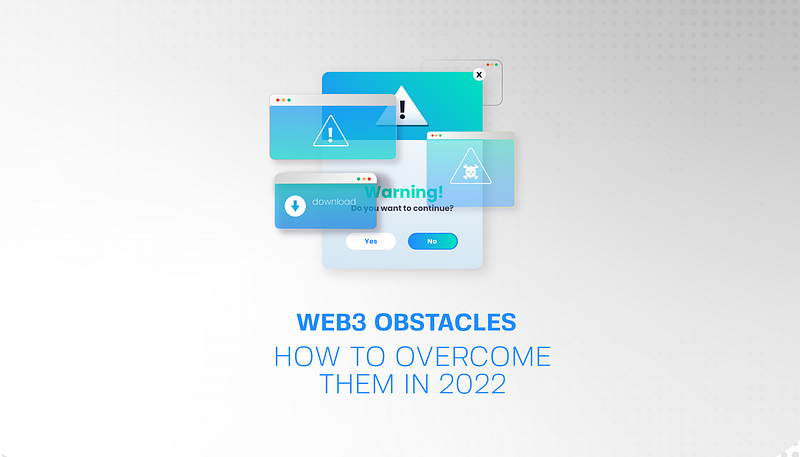Web3 Obstacles & How to Overcome Them in 2022

In April 2021, over 530 million Facebook users’ data, including their names, locations, phone numbers, email addresses, and biographical information, was posted online for free. Another crucial and saddening statistic also shows that the number of breaches in the U.S has significantly increased in the last decade from about 662 in 2010 to more than 1,000 by 2021.
It’s no wonder that 74 % of internet users in the United States are as worried about their online privacy today as they have ever been, and 79 % of internet users around the world have agreed that they feel somewhat incapable of control of their data.
Web3 promises to be the future of the internet. It promises to restore data into the hands of its owners and give them full control over decisions regarding their data.
Despite the big promises and future web3 presents to users, many obstacles hinder mass adoption of it. Let’s discuss these obstacles in more detail.
COMPLEX UI
The user interface of most web3 applications can be complex and difficult to navigate, from setting up a wallet, connecting your wallet, purchasing crypto, or even providing liquidity and staking.
This complex user interface is one turn-off for new users as they get overwhelmed, leading to a bad experience. Most web3 apps are built to focus on the technical people while neglecting the needs of the less technical users, which isn’t going to lead to fast adoption.
The UI of Web3 applications can be better if the companies concerned pay more attention to how their designs influence the onboarding of users, especially beginners. A good UI can increase customer acquisition. Grants should also be offered to designers to develop different designs sent to the developers for implementation.
SECURITY & TRUST
How will web3 projects ensure these security concerns are appropriately addressed? How safe are the smart contracts on which most web3 apps are built? With web 2.0, users are familiar with 2-factor authentication and SSL security as methods of staying safe. The security standards of web3 aren’t familiar to most users yet.
Web3 projects should be taking the security of their users as their first priority and ensure to communicate this to users in the easiest way through all available platforms.
As with any new project, people are yet to trust the authenticity of web3. With much false information about web3 and even different projects claiming to support web3 but falling short in other areas, it is harder but not impossible to get the trust of people.
The issue of trust can be tackled by being transparent with users. Always ensure you warn users about possible risks and how to avert them.
SCALABILITY & GAS FEES
Scalability is a hindrance to web3 adoption. For transactions to be confirmed on the blockchain, users must pay gas fees. The gas fees paid on the Ethereum network can soar into hundreds of dollars, making it unaffordable for ordinary users.
While popular blockchains are prone to scalability issues, newer blockchains have been developed to address this issue. Web3 projects can leverage the benefits of these new blockchains that provide faster transaction speeds and low gas fees to provide seamless services to users
POOR EDUCATION & MARKETING
For most new products, users need to learn how to use them before delving into using them. The same happens in web3. Users need to know about blockchains and how they work: smart contracts, protocols, wallets, etc. Most users can find it confusing to understand, hence giving up on web3.
Poor marketing also contributes to this as most web3 companies focus more on building their projects without spending much time analyzing how to market this to the public in a simple and clear manner. Web3 education and marketing should cut across different technical experiences, be it beginners, intermediate or expert users of web3.
Web3 projects can adopt the following educational ideas:
- The use of long-form blog posts to educate the online audience about web3, its advantages, and how it works
- Video content, infographics, ebooks, podcasts, and other types of content should be released for educational purposes.
- Participation in webinars, AMAs, and spaces should be encouraged
- Offline events and meetups should be organized to enlighten the offline audience and also create a bond among web3 users
- Social media also plays an essential role in web3 education and should not be overlooked.
Conclusion
Web3 is still in its infancy stage, and we are yet to see its full benefits. If the issues that hinder the adoption of web3 are addressed, users are sure to have a smooth ride and see faster adoption in the future.
Disclaimer: This post is not financial advice
Find us at www.pointnetwork.io
Join our Telegram at: https://t.me/pointnetworkchat